British Armour of the Second World War - The Infantry Tank
In the early days of armoured warfare Britain was the world leader in armoured forces and along with France set the baseline for the tank and what function it should perform. The driving concept behind the development of British armoured forces in the mid 1930's was that of three distinct roles to be carried out by three distinct and totally separate types of tank. The subject of this post is the role for which the tank had originally been developed, to work in close co-operation with the infantry to achieve breakthrough of enemy defences.
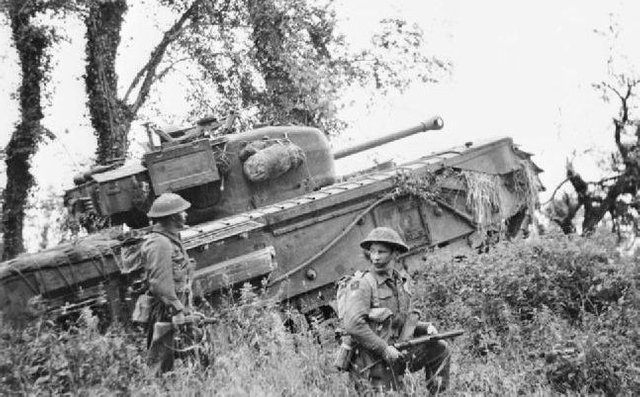
The Infantry Tank concept came into being in the mid 1930's, a time when the British Armoured forces was being reduced by financial constraints and lack of vision into a terrible condition, Smithers says of this time: "in 1934 the Royal Tank Corps possessed the best machines in the world and the men who knew how they should be handled in battle. By 1938 that had all gone, save for the quality of the tank crews." As re-armament became a political issue new weapons systems were sought out and technical requirements were issued. Given the parlous state of the nation's finances at the time, one of the most important requirements for the new Infantry Tank was that it had to be inexpensive, in addition this vehicle would need to be slow moving to allow the infantry to keep up and heavily armoured enough to stay alive when moving slowly across a battlefield. It's gun should be sufficient to effectively engage infantry strong points (a machinegun was initially selected), no anti-tank role was originally envisioned for the Infantry Tank. The idea was for huge numbers of thes vehicles to overwhelm enemy entrenchments and strong points and allow the infantry to come to grips with the enemy at little cost, these concepts were all well and good, but they were based on the premise of a military stasis, that the next war would be just like the last one; it wasn't!
A11 Matilda I
The A11, Matilda I, Infantry Tank was a design that would have served relatively well during the First World War, however at this juncture it was woefully behind the times. Its armament of either a .303 or .50 calibre Vickers machine gun was capable enough to engage infantry defensive positions, but against even moderately armoured vehicles these weapons would fall short. The Matilda 1 also met its requirements for speed, it found it difficult to keep up if the infantry decided to run. The armour however was a great success and, in action in 1940, German anti-tank guns failed to penetrate the main armour protection of the vehicle, unfortunately the suspension was vulnerable to all sorts of mishap in action.
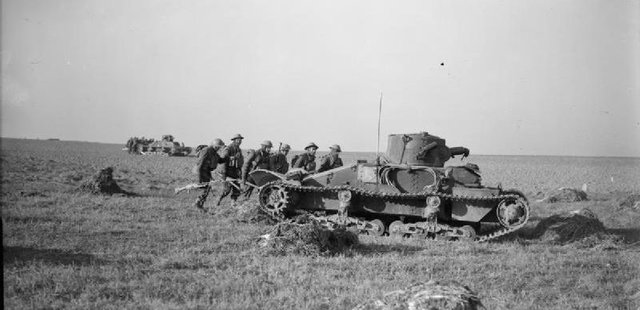
A11 Matilda I training with 2nd Bn North Staffordshire Regiment 1940 (Imperial War Museums).
A11 Matilda II
It soon became apparent that military technology was moving on apace and a larger, better armed and better armoured vehicle was required to fulfil the role of infantry tank. This line of thinking can lead to the specification A12 and the advent of the Matilda II. The Matilda II was twice as heavy as the A11 and carried a four-man crew as opposed to the two men who operated the Matilda I. The armour of the Matilda II was even heavier than that of the Matilda one, although mounting two engines side-by-side allowed this vehicle slightly better speed and manoeuvrability. The armament of the Matilda II was the excellent Ordinance QF 2 pounder (40mm) anti-tank gun with a 7.92 mm BESA coaxial machine gun. Strangely, this weapon was not issued with high explosive ammunition and so was unable to effectively support infantry in action. This inexplicable oversight led the Matilda II to be used more in the tank against tank role than in that for which it was intended. In action, in France and North Africa, German troops found that while there anti-tank guns were quite capable of scratching the paintwork of a Matilda II (deeply offending the crews of these vehicles), it took either an anti-tank minefield, an artillery bombardment, Stukas or an 88mm anti-aircraft gun to actually stop an attack by the Matilda II. The A12 was a slow, but incredibly tough tank for its time and came to be known affectionately as "the Queen of the Desert".
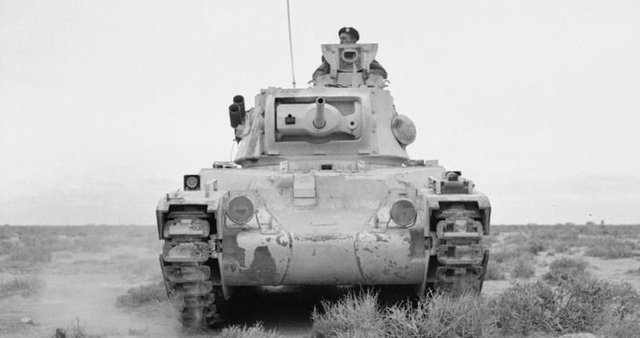
Matilda II North Africa 1942 (Imperial War Museums).
Valentine
After the start of World War II it soon became apparent that a large number of tanks would be required in a very short period of time and so it was decided on February 14th, Valentine's Day, 1940, to develop an infantry tank that would be comparable to the Matilda II, but cheaper, quicker and easier to produce. To achieve this end, many design aspects of the A10 heavy cruiser tanks that had already been in production were used. The vehicle was basically and A10 cruiser with a thicker armour, a more powerful engine and design modifications. The early Valentines used a small, two-man turret that was smaller than used on the Matilda II, although later versions use larger turrets mounting first a Ordinance QF 6 pounder and then 75 mm gun. The Valentine was inferior to the Matilda II in almost always, those exceptions being cost per unit, speed of production and the ability to be fitted with a larger turret. More than 8000 of these little-known vehicles were produced during the war, many being exported to the Soviet Union. The name Valentine comes, like its predecessor, Matilda from the in-house code word for the vehicle used by the manufacturer Vickers during development. Another strange facts with regards to its nomenclature is that, unlike virtually all other British tanks of the time, it had no A number designation.
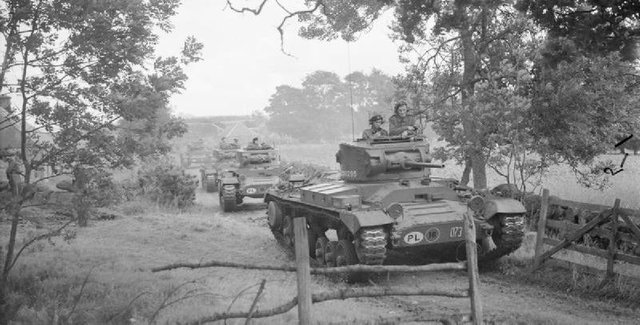
Valentine tanks of the 1st Polish Corps on exercise in Scotland 1941 (Imperial War Museums).
A22 Churchill
After the fall of France the British Army examine and the conduct of war in Europe over the first year of fighting and came up with the specification for a new Infantry Tank, the A20, eventually the A22 Churchill. Intending to address many of the problems of earlier vehicles, the Churchill was going to be superior in all aspects to its predecessors. However the realities of design and production under war conditions led to the early versions of the tank to perform poorly in action. It was not until the excellent performance of the MkIII at El Alamein in 1942 that the Churchill proved its worth in action. Despite its rather flat, slab sided armour making a good target for anti-tank gunners it152mm of protection served it well in action. This is twice the armour protection available to the Matilda II. The selection of a suitable gun to mounted in the Churchill took time with the initial vehicle mounting a Ordinance QF 2 pounder in the turret and a 3 inch howitzer in the hull. This configuration was discontinued after the Dieppe Raid and a single turret mounted weapon was utilised. In 1941 the Ordinance QF 6 pounder (57mm) was mounted and gave good service, but after some highly successful experimentation in North Africa with guns removed from damaged M4 Shermans, it was decided to fit a British made 75mm gun, the Ordinance QF 75mm. With this weapon the Churchill had the capability to engage both armoured and infantry targets to great effect and so fulfill the concept of an infantry tank properly for the first time.
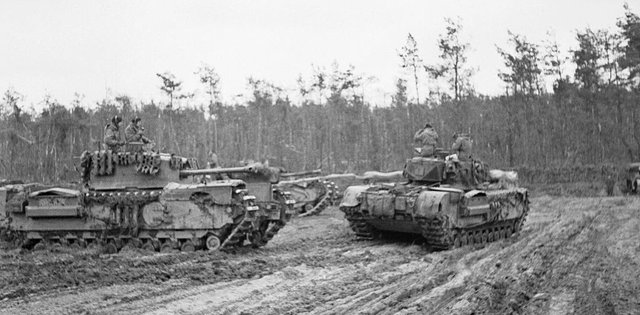 Churchill tanks of 107th Regiment RAC (King's Own), 34th Tank Brigade, at the start of the Reichswald battle, 1945 (Imperial War Museums).
Churchill tanks of 107th Regiment RAC (King's Own), 34th Tank Brigade, at the start of the Reichswald battle, 1945 (Imperial War Museums).
The Churchill was the last of the infantry tanks in British service, the infantry support role was taken on by the new concept of the "Universal Tank", the A34 Centurion, later to become known as the main battle tank.
Infantry tanks were slow, at full speed, on good ground the fastest of them could make 15 or 16 mph, this is what an infantry tank at speed looks like.
Matilda I and Valentine II at Bovington by lobomau
Bibliography
British and Commonwealth armies in 1939-43 - Mark Bevis
British and Commonwealth armies in 1944-45 - Mark Bevis
History of the Second World War - Winston S. Churchill
The Matilda Infantry Tank - David Fletcher
The Royal Tank Regiment - George Forty
Achtung Panzer - Heinz Guderian
History of the Second World War - Basil Liddel Hart
The Churchill Infantry Tank - Bryan Perrett
France 1940 - Alan Shepperd
A New Excalibur - A. J. Smithers

Beep! Beep! This humvee will be patrolling by and assisting new veterans, retirees, and military members here on Steem. @shadow3scalpel will help by upvoting posts from a list of members maintained by @chairborne and responding to any questions replied to this comment.
Another absolutely brilliant & informative post !!!
Many thanks.